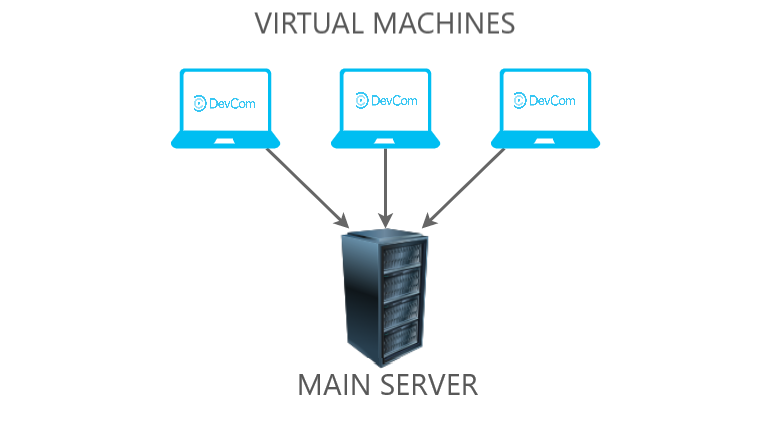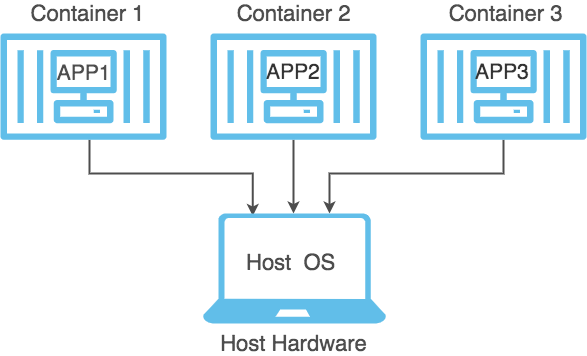Develop and Run Applications without Thinking about Servers
If you’re navigating the landscape of questions about the best way to build, deploy, and manage applications, you’ll be able to find some answers below. We’ll analyze the three most popular cloud technologies – containers, virtual machines, and serverless computing. The new buzzwords in town have been gaining a lot of attention from the pros and the rookies in the tech and for a good reason. When used the right way, cloud technologies can assist you in running applications without thinking about servers. It sounds quite pleasant to the ears and is probably light on the budget as well.
Contents
- 1 Develop and Run Applications without Thinking about Servers
- 2 What Is a Virtual Machine (VM)?
- 3 How Do Virtual Machines Operate?
- 4 What Are Containers?
- 5 How Do Containers Operate?
- 6 Virtual Machine vs. Containers: main differences
- 7 What is Serverless?
- 8 Serverless Computing: How Does It Work?
- 9 Serverless vs. containers: How to choose
- 10 Finding the Balance in the Enterprise
- 11 FAQ
What Is a Virtual Machine (VM)?
A virtual machine (VM) is a piece of software that mimics the functions of a computer. In a sense, a VM is a computer created by another computer.
VM can execute applications and programs without the need to use physical hardware. It is isolated from the rest of the machine that hosts it and behaves as if it is the only operating system on it.

Benefits of virtual machines
- ⇒ Partitioning. VMs run multiple operating systems on one physical computer.
- ⇒ Isolation. VMs provide fault and security isolation at the hardware level.
- ⇒ Encapsulation. Save the entire state of a virtual machine to files.
- ⇒ Hardware independence. Provision of any virtual machine to any physical server.
The main disadvantages of virtual machines are:
- ⇒ Slow running. VMs are less efficient than physical machines because they access the hardware indirectly.
- ⇒ Low performance. When several VMs are running on the same host, performance may be hindered.
How Do Virtual Machines Operate?
Every VM runs its own unique guest OS (operating system), thus enabling a group of VMs to sit alongside each other, each one with its unique OS. Multiple operating systems run side-by-side with a piece of software called a hypervisor to manage them. At the same time, desktop computers typically employ one OS to run the other operating systems within its program windows.
For instance, a UNIX VM can sit beside a Linux VM, and every VM has a virtual hardware stack of its own comprised of libraries, binaries, applications, storage, network, and a unique CPU.
The virtual hardware is mapped to the real hardware on the physical machine , which saves costs by reducing the need for physical hardware systems along with the associated maintenance costs that go with it.
The OS on the VM recognizes components as the ones to construct a computer and thus uses them to run OS and applications on the VM.
The VM is sandboxed from the rest of the system, meaning that the software inside a VM can’t escape or tamper with the computer itself. It produces an ideal environment for testing other operating systems, including beta releases, accessing virus-infected data, backups, and running software or applications on OS they weren’t originally intended for.
Virtualization brings you many advantages. VMs allow you to consolidate multiple applications into one server, but as it is always the case, it has certain shortcomings, too. Because every VM has an OS, some significant issues can arise – especially when large projects are involved. Consequently, problems come about throughout the pipeline of software development.
Having numerous VMs with operating systems of their own adds significant overhead with regard to storage footprints and RAM. The concept is to partially use the host’s or the primary resource to provide an isolated environment for the new system. The assignment of resources is absolute. For example, if the virtual machine is assigned 1 GB of memory and uses 50% at a time, the remaining 50% will be useless, and it would be a waste of resources. There is no way to utilize that 50% in the case of virtualization. The same applies to each resource.
This results in the degradation of systems performance. No matter how highly configured the system is, there will always be a certain percentage of resource wastage in virtualization, meaning that virtualization is useful for small-scale businesses.
In other cases, containers are what you need. Because they share system resources with the host server rather than emulating a virtual OS, they are more efficient than VMs.
What Are Containers?
Containers are a lightweight virtualization architecture that allows you to deploy individual applications inside portable, isolated environments.
A single container might be used to run anything from a small microservice or software process to a larger application. Inside a container, there are all the necessary executables, binary code, libraries, and configuration files, in common ways so that they can be run anywhere, whether it be on the desktop or the cloud.
Although the features of containers and serverless architectures overlap in some respects, they are not interchangeable technologies. Compared to the server or virtual machine approaches, containers do not contain operating system images. This makes them more lightweight and portable, with significantly less overhead. In larger application deployments, multiple containers may be deployed as one or more container clusters. Such clusters might be managed by a container orchestrator.
Just as a computer can be virtualized by a VM, containers can virtualize whole operating systems so that numerous workloads can operate on one OS. With virtual machines, the hardware runs on multiple operating systems virtually, slowing things down while gradually increasing the overall ownership cost. To bypass this, one OS is leveraged by containers, which enhances portability and deployment speed while reducing expenses.
As with VMs, an environment is provided by a container to deploy, manage, and scale microservices independently in a streamlined manner.
By isolating an application from the external host environment, containers enable frictionless application deployment.

Benefits of containers:
- ⇒ Increased portability. Containers are small, fast, and portable because, unlike a virtual machine, containers do not need to include a guest OS in every instance and can, instead, leverage the features and resources of the host OS.
- ⇒ Reduce complexity through abstractions. The primary advantage of containers, especially compared to a VM, is providing a level of abstraction that makes them lightweight and portable.
- ⇒ Less overhead. Containers require fewer system resources because they don’t include operating system images.
- ⇒ Better application development. Containers support agile and DevOps efforts to accelerate growth, test, and production cycles.
- ⇒ Better security and governance.
Container disadvantages:
- ⇒ Higher cost. Using containers for new applications adds about 30 percent to the cost of development versus not using containers.
- ⇒ Botched container architectures. Some container products don’t work with others — usually due to competition between the companies that back them.
- ⇒ Not all applications benefit from containers. In general, only applications that are designed to run as a set of discrete microservices stand to gain the most from containers.
How Do Containers Operate?
For all intents and purposes, containers look like a VM. But how are containers different from virtual machines? They have private space for processing, can execute commands as root, have a private network interface and IP address, allow custom routes and IPtable rules, can mount file systems, etc.
The easiest way to understand how containers work is to know how they differ from virtual machines. The one big difference is that containers in cloud computing share the host system’s kernel with other containers.
Containers offer hardware virtualization at an OS level (typically Linux), so each individual container contains only the application, its libraries, and dependencies.
The absence of the guest OS is why containers are so lightweight and fast.
And while containers resemble virtual machines (because they have private processing spaces, IP addresses, and networks of their own), the main distinction between VMs and containers is that the latter shares a host’s OS with several other containers, making them lightweight. Containers are also able to execute commands and can mount filesystems.
There are key use cases where containers are especially relevant:
- Microservices: Containers are small and lightweight, which makes them a perfect match for microservices, where applications are constructed of small, independently deployable services.
- DevOps: The combination of microservices as architecture and containers as a platform helps to build a well-designed container deployment strategy, orchestrate container infrastructure, and find the optimal ways to make deployment faster, more secure, and seamless.
- Hybrid cloud: Containers are an ideal underlying architecture for hybrid cloud and multi-cloud scenarios because they can run consistently across laptops, on-premises, and cloud environments.
- App modernizing and migration: By containerizing, applications can be easily migrated to the cloud.
Virtual Machine vs. Containers: main differences
Before diving into differences, let us state that both virtual machines and containers help improve operational efficiency. Nevertheless, the main difference between containers and virtual machines can be compared to houses. Vms are like separate houses with their own infrastructure, while containers are like apartments that share the same building.
Virtual machines require their own operating system, memory, and resources. It leads to higher overhead and longer startup times. On the other hand, containers share the host operating system and, consequently, are more lightweight, with faster startup times and greater scalability.
Moreover, VMs offer more robust isolation between applications, resulting in being more suitable for running legacy or diverse applications. At the same time, containers are perfect for the development and deployment of modern applications with the agile approach, as they provide a high level of portability and flexibility.
The choice lies in defining your main requirements and needs of the project to make the right decision.
What is Serverless?
Serverless is a cloud computing execution architecture where the cloud provider manages the allocation and provisioning of servers. There is no server to maintain; the only work necessary to run the code is to upload it and trigger it when it should execute. Serverless computing eliminates infrastructure management tasks such as a server or cluster provisioning, patching, operating system maintenance, and capacity provisioning.
The cost model of serverless is execution-based: you’re charged for the number of executions rather than pre-purchased compute capacity. A company that gets backend services from a serverless vendor is charged based on usage, not a fixed amount of the number of servers.
The downside is that serverless functions are accessed only as private APIs. This doesn’t have an impact on your pricing or process, but it means you cannot directly access them through the usual IP.
Businesses can leverage cloud-based and external servers, which are maintained and run by companies such as Amazon AWS. An example of a serverless platform is:
Serverless architecture has been beneficial in introducing concepts like Backend-as-a-Service (BaaS) and Function-as-a-Service (FaaS). The former is generally used by applications with a “rich client” designation, such as mobile apps or one-page online apps that rely on a broad ecosystem. Such ecosystems are comprised of authentication services (AWS Cognito and Auth0, for instance), as well as cloud-based databases.
Therefore, serverless computing can also be defined as a FaaS since the company requests an outside server functionality, rendering them “serverless” (without being function-less).
Benefits of Serverless Architecture:
- ⇒ Lower costs. The cost incurred by a serverless application is based on the number of function executions, measured in milliseconds instead of hours.
- ⇒ Simplified scalability. The serverless vendor handles all of the scalings on demand.
- ⇒ Agility. Smaller deployable units can significantly cut the time to deliver new features to the market. Customers are receiving new features quicker than before.
- ⇒ Simplified backend code. With FaaS, developers can create simple functions that independently perform a single purpose, like making an API call.
- ⇒ Reduced liability. No backend infrastructure to be responsible for.
Drawbacks of Serverless:
- ⇒ Reduced overall control.
- ⇒ Cost is unpredictable because the number of executions is not predefined.
All of these and other drawbacks like security and disaster recovery risks can be mitigated with open-source alternatives but at the expense of cost benefits.
Serverless Computing: How Does It Work?
One instance of a FaaS is Lambda, which allows you to call functions using applications that run on AWS services, such as EC2 or S3. After a function is called, Lambda deploys it to a container that runs until a function is fully executed. Lambda handles the provisioning, deployment, and management of the code. You simply need to upload it.
Serverless is usually quantified against containers because each technology offers similar task development benefits. With that said, be mindful that serverless containerization and computing don’t cancel each other out – they work in conjunction with one another.
Serverless vs. containers: How to choose
Be it serverless or containers, serverless computing doesn’t eliminate the necessity for developers to handle containers directly. The code still needs to be written and loaded to Lambda. A completely serverless project will be hard to handle. Although AWS Lambda is an invaluable resource, it’s not an overall replacement for container deployment and management using applications like Kubernetes and Docker.
There are some stringent limitations when it comes to the choice of serverless computing vs. containers. When Lambda is used, for instance, you will be subjected to memory usage limits, pre-established size restrictions, and a designated time for a function to be run. In addition to the narrow list of programming languages that are natively supported, the constraints of running the system using serverless architecture are pretty apparent.
For serverless architecture to be run successfully, functions need to be kept small to stop them from overloading or hogging a system. Containers used in serverless environments aren’t managed or defined by you. Instead, they are regulated by a provider who offers you the capacity to have serverless functions executed. Since these containers are out of your direct reach, you won’t have the ability to track performance, directly debunk them, or quickly scale them.
Docker ecosystems don’t restrict you to a pre-established memory, size, or time for a function to be run. An application can be built as complex and large as you desire, which will give you total control over the container system (as well as individual containers) through software dedicated to container management.
Ultimately, containers and serverless architecture work optimally when they are leveraged with one another. So, whether serverless or containers , you have to remember the following. Applications that are Docker-based are optimal for complex and large-scale applications. Serverless architecture is better suited to small tasks that can be accessed through external services to run behind the scenes.
If a program that is container-based needs to be run, certain functions can be outsourced to serverless platforms for the sake of freeing up the primary program’s resources. As a result, the choice between serverless vs. containers depends on specific needs and requirements, desired level of scalability, and ease of management.
Finding the Balance in the Enterprise
When deciding between serverless vs. containers and containers vs. virtual machines, – each of them has its own respective strengths and differs in several important ways. Choosing the suitable cloud deployment model for your application is vital to your company’s success. Try to understand all the advantages and disadvantages of various options.
Rather than thinking in terms of containers vs. serverless vs. virtual machines, think of them as technologies that complement each other. When serverless computing, containers, and virtual machines are used in tandem with one another, their strengths get amplified.
If you have questions on how to optimize the cost and performance of your cloud infrastructure, feel free to get in touch with DevCom cloud architects.
FAQ
Is A VM faster than a container?
When comparing the performance speed of a container vs. a virtual machine, we should state they are both unique in their runtime. However, containers have faster startup times as they share the host operating system and are lighter than VMs.
What is the disadvantage of containers over VM?
Apart from the advantages of containers over virtual machines, there are some disadvantages. The main drawback lies in its benefit. Containers share the same OS as the host. It means that if the host OS experiences some security breach or hiccup, it may affect all the containers. Compared to VMs, containers do not provide the same level of isolation that is required for strict security and compliance applications.
What is the difference between containers and virtual machines
The differences between containers and virtual machines are as follows:
Containers:
- ⇒ are lightweight and modular
- ⇒ share the host OS
- ⇒ have increased scalability
- ⇒ are suitable for modern application development and deployment
Virtual Machines:
- ⇒ are fully contained with their own operating system
- ⇒ require their own OS
- ⇒ provide stronger isolation between applications
- ⇒ are suitable for running diverse workloads
Written by: Liza Hazevych, Marketing Manager at DevCom.





